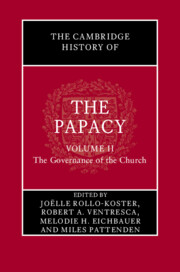Book contents
- The Cambridge History of the Papacy
- The Cambridge History of the Papacy
- Copyright page
- Contents
- Figures
- Tables
- Maps
- Contributors
- General Introduction
- Part I The Pope within the Church
- Part II The Roman Curia
- 6 Putting the Spoke(s) in: Curial Centrality and Local Agency in the Pre-Reformation Church
- 7 The College of Cardinals
- 8 The Secretariat of State
- 9 The Papal Penitentiary
- 10 “Whoever is sent from another”: Legates as Instruments of Papal Government
- 11 Inquisition, Holy Office, and the Congregation for the Doctrine of the Faith
- 12 Nepotism and Roman Micro-Policy
- Part III Canon Law
- Part IV Finance
- Part V Papal States
- Select Bibliography
- Index
9 - The Papal Penitentiary
from Part II - The Roman Curia
Published online by Cambridge University Press: 28 February 2025
- The Cambridge History of the Papacy
- The Cambridge History of the Papacy
- Copyright page
- Contents
- Figures
- Tables
- Maps
- Contributors
- General Introduction
- Part I The Pope within the Church
- Part II The Roman Curia
- 6 Putting the Spoke(s) in: Curial Centrality and Local Agency in the Pre-Reformation Church
- 7 The College of Cardinals
- 8 The Secretariat of State
- 9 The Papal Penitentiary
- 10 “Whoever is sent from another”: Legates as Instruments of Papal Government
- 11 Inquisition, Holy Office, and the Congregation for the Doctrine of the Faith
- 12 Nepotism and Roman Micro-Policy
- Part III Canon Law
- Part IV Finance
- Part V Papal States
- Select Bibliography
- Index
Summary
The papal penitentiary was the highest office in the later medieval Church concerned with matters of conscience. It granted absolution in cases where this was reserved to the papacy, notably for grave sins such as assaults on clergy, and it issued other graces that were also a papal monopoly, such as dispensations, notably for marriages within the prohibited degrees of kinship, and special licences, especially to appoint a personal confessor. Laity and clergy across later medieval Europe petitioned the office for these favours. The papal penitentiary hence represented a significant point of contact between the papacy and individual Catholics. Its origins were obscure but partly lay in the long tradition of penitential pilgrimage to Rome. Minor penitentiaries heard confessions of penitent pilgrims at Rome’s major basilicas, including Saint Peter’s. By the early thirteenth century, the ‘major penitentiary’ in charge of the office was appointed by the pope from among the cardinals and received growing faculties to concede graces on the pope’s behalf. By the fifteenth century, the office that he headed was a major department of papal government and substantial source of revenue for the papacy.
Keywords
- Type
- Chapter
- Information
- The Cambridge History of the Papacy , pp. 237 - 260Publisher: Cambridge University PressPrint publication year: 2025

